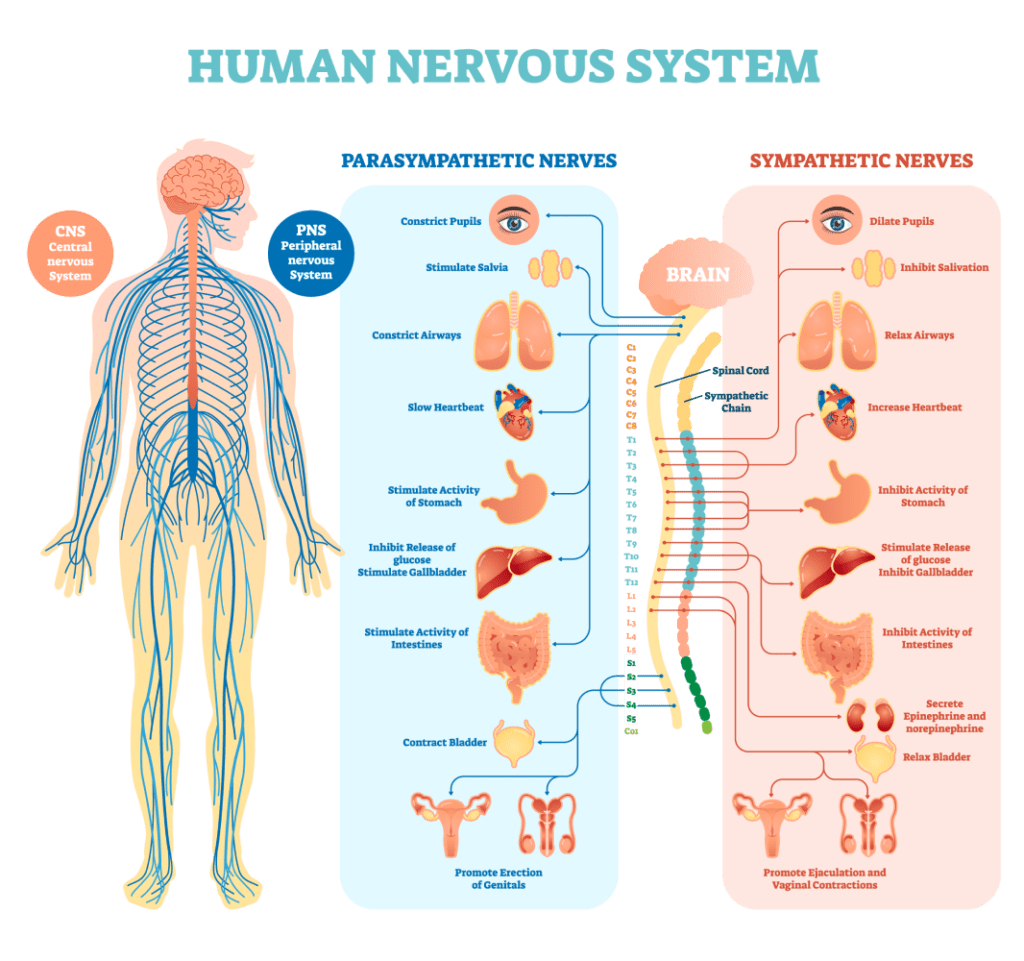Safe and natural relief for PTSD/PTSI, anxiety, panic attacks, and depression.
Did you know that there is a safe and effective treatment for PTSD/PTSI that’s been around for almost 100 years that most people have never heard of? The procedure, is called a Stellate Ganglion Block, or SGB, and it essentially resets the fight-or-flight part of the nervous system, giving those suffering from PTSD, PTSI, high anxiety, or depression a new start at life where their symptoms can be alleviated almost immediately.
Recently, a study that followed 75 patients with diagnosed PTSD for six months after receiving 2LCSB was published that showed 96% of patients saw long-lasting PTSD symptom relief.1
Here’s what they found:
- 96% of patients showed significant improvement
- On average, PTSD symptoms were reduced by 55%
- Some trauma types—such as sexual assault and childhood abuse—showed improvement rates over 70%
- Benefits were long-lasting, not just a temporary fix
Patients filled out a standardized PTSD checklist (PCL-5) at five different intervals—from right before the procedure to six months later. The results showed not just immediate relief, but sustained changes in well-being.
NW Regen in Portland, Oregon specializes in minimally invasive SGB treatments at the skilled hands of one of America’s top SGB experts, Dr. Ryan Wood. As a pioneer and recognized leader in the field of SGB injection therapy, Dr. Wood has completed 2,000+ SGB procedures, lectures domestically and internationally, and provides hands-on physician training globally to those wishing to learn this incredible modality.
“The Stellate Ganglion Block is a minimally invasive procedure that takes less than 15 minutes and can have near instant results for those suffering from PTSD/PTSI by putting fight-or-flight responses back into balance.”
– Dr. Ryan Wood, Clinical Director NW Regen
Having offered the treatment since 2017, NW Regen has designed a unique approach. During each session, we conduct a “Dual Sympathetic Reset” (DSR), which you’ll learn more about below and discover is more comprehensive than what most clinics provide. Also known for our compassionate care and methodology, NW Regen informs and involves patients at every step of the procedure, ensuring a treatment plan as unique as you are.
For an even broader spectrum of care, we’ve developed a support network of resources and practitioners, including additional types of treatments that assist in recovery from post-traumatic stress-related injuries. Our team approach, combined with the DSR SGB procedure, can be extremely beneficial for those with PTSD/PTSI.
To help dispel any mystery about our form of DSR SGB and help educate the public about the massive potential to alleviate suffering from trauma, let’s explore:
- How do Stellate Ganglion Blocks (SGBs) work?
- Who can benefit from SGBs?
- Why is “Dual Sympathetic Reset” important?
- What proof is available that SGB is a viable treatment for PTSD/PTSI?
- How can a patient ensure they’re getting the best care possible?

How do Stellate Ganglion Blocks (SGB) work?
Stellate Ganglion Blocks (SGBs) require injecting a local anesthetic into the stellate ganglion—a group of nerves in the neck that helps to regulate the body’s autonomic nervous system.2 They have the ability to “reset” the nervous system to a pre-trauma state, similar to rebooting a computer.
According to RTI International, an independent third-party nonprofit medical research facility dedicated to improving the human condition, the procedure was traditionally done using X-ray to identify the stellate ganglion area, but today, ultrasound is the gold standard due to its greater accuracy in visualizing the structure.3
“I cannot emphasize enough the critical importance of expertise and precision in these procedures,” says Dr. Ryan Wood. “Utilizing ultrasound or fluoroscopy for injection guidance is non-negotiable for us.” Adhering to the highest standards of best practice, our NW Regen team utilizes ultrasound technology for:
- Visualizing anatomy,
- Monitoring blood flow, and
- Guiding each injection with the highest level of care.
When we inject an anesthetic (using an ultrasound for visual guidance), it blocks the nerve highway that carries information responsible for triggering fear and anxiety-based responses. Researchers think a reason SGBs may help PTSD/PTSI is due to a decrease in nerve growth factor levels, which reduces norepinephrine levels while also reducing the increased sympathetic nervous system activity that happens with PTSD/PTSI.4
“There’s consistent agreement that SGBs can regulate the autonomic nervous and cerebrovascular systems, dilate blood vessels, and improve circulation,” Dr. Wood explains. “So, the procedure is widely used in the treatment of head, neck, and upper limb pain. It’s therefore logical that SGBs can be used to address dysautonomia – a term that describes when a person’s body cannot keep balance between the two opposing systems of the autonomic nervous system, a.k.a. the Yin and Yang of the body’s nervous tree.”

SGBs put the body’s autonomic system back in balance.
“The Stellate Ganglion Block is a minimally invasive procedure that takes less than 15 minutes and can have near instant results for those suffering from P“The parasympathetic (rest and digest) and sympathetic (fight or flight) parts of the nervous system are opposing. Like the scales of justice, they need to find balance.”TSD/PTSI by putting fight-or-flight responses back into balance.”
– Dr. Ryan Wood, Clinical Director NW Regen
Who can benefit from Stellate Ganglion Blocks or SGBs?
Up to 8 million adults in the US develop Post-Traumatic Stress Disorder (PTSD) each year.5 Commonly associated with war veterans and first responders, PTSD can occur after any traumatic event—including natural disasters, serious accidents, or physical or sexual assault. While Post-Traumatic Stress Injury (PTSI) is an alternate name – referencing the same set of symptoms – PTSD refers to a disorder, and PTSI refers to a biological injury.
Other mental, emotional, and health conditions that can be treated with SGB include:
- Anxiety and/or Work-related stress
- Traumatic Brain Injury (TBI)
- Long COVID symptoms
- Chronic Fatigue Syndrome (CFS)
- Dysautonomia
- Postural Tachycardia Syndrome (PoTS)
- Parosmia (distortion of smell)
- Anosmia (loss of smell)
- Sleep problems and nightmares
- Postpartum depression
- Complex Regional Pain Syndrome (CRPS)
- Reflex Sympathetic Dystrophy (RSD)
- Compartment syndrome
- Causalgia from nerve injuries
- Autonomic dysfunction of the upper extremity
- Herpes zoster infection (or “shingles”) affecting the head, neck, arm or upper chest
- Phantom limb pain

“We aren’t just what we eat, we are what we think as well. Chronic stress, or chronically dominated sympathetic autonomic nervous system can and does manifest in such things as cardiovascular disease, chronic fatigue, chronic pain syndromes, cancers, and a whole host of other issues.”
– Dr. Ryan Wood, Clinical Director NW Regen
Why is “Dual Sympathetic Reset” important?
Stellate Ganglion Blocks are precise, ultrasound-guided injections aimed at the sympathetic nerve bundle in the neck. These blocks are instrumental in managing a range of mental health conditions by modulating the body’s stress response. They block the traffic in the cervical sympathetic chain, so the parts of the brain that control the fight or flight response are allowed to completely reset. This results in long-term relief.
Multiple peer-reviewed medical studies show a right-sided SGB results in significant long-term improvement in chronic anxiety symptoms associated with PTSD/PTSI. However, there are variations on how the procedure is performed. At NW Regen, during each session, we conduct a thorough “Dual Sympathetic Reset” or “DSR,” targeting both the C3 and the C6 levels for a more comprehensive treatment than typically offered — as most clinics focus solely on the C6 level. Our approach is designed to inform and involve you at every step of the way, ensuring a treatment plan that’s as unique as you are.
Our standard treatment involves two injections within 10 to 14 days. The first injection resets the nervous system, and the second injection builds upon the first dose to improve results for most patients. For some conditions like reflex sympathetic dystrophy or complex regional pain syndrome, we perform this procedure weekly for up to six to eight weeks. Some patients also benefit from additional injections several months later.

What proof is available that SGB is a viable treatment for PTSD/PTSI?
SGB was first used in the U.S. in 1925 to provide relief from chronic pain and then used again for depression in 1945 at The Cleveland Clinic. It was also used to help German prisoners of war recover from their experiences in Russian camps during World War II. However, experts believe it wasn’t used regularly until sometime after 1998.
RTI International is an independent, nonprofit research institute. In a search for effective therapies for PTSD, they instigated a study in 2014 and published their findings in 2019. While SGB has been used for nearly a century to treat chronic pain, this was the first multisite randomized trial for using it to treat PTSD.6
“We aren’t just what we eat, we are what we think as well. Chronic stress, or chronically dominated sympathetic autonomic nervous sSGB is a true breakthrough in PTSD treatment. It is a powerful new option for people suffering from PTSD and shows early promise for treating generalized anxiety disorder and major depressive disorder.ystem can and does manifest in such things as cardiovascular disease, chronic fatigue, chronic pain syndromes, cancers, and a whole host of other issues.”
– RTI Institute7
“Some people described the treatment as opening a door,” stated Kristine Rae Omsted, Senior Research Epidemiologist at RTI and the study’s co-primary investigator. “While some felt significantly less anxious even when they thought about the trauma, so they were then able to do the talk therapy willingly and effectively.”8
In their study results, RTI states, “This option may be more readily accepted by military service members and veterans, for whom the stigma associated with mental healthcare is often a deterrent to seeking treatment.”
How can a patient ensure they’re getting the best care possible?
NW Regen is a pioneer and recognized leader in Stellate Ganglion Block (SGB) treatments on the west coast, serving a diverse community of patients from across the US, Canada, and beyond. We cannot emphasize enough the critical importance of expertise and precision in these procedures. Our extensive experience underscores our commitment and established position as leaders in this field.
At NW Regen, any therapy used is most transformative as part of a holistic treatment plan, where we partner with you, foster a conducive space for healing, and provide continual support throughout your recovery process. We also design personalized nutritional, exercise, and lifestyle plans specifically for your needs, which add to you improving your mental health and well-being. Talk with our specialists about how we can help.
- Long-Term Durability of Bilateral Two-Level Stellate Ganglion Blocks in Posttraumatic Stress Disorder: A Six-Month Retrospective Analysis ↩︎
- https://www.ncbi.nlm.nih.gov/books/NBK539845/ ↩︎
- https://www.rti.org/impact/stellate-ganglion-block-new-treatment-ptsd ↩︎
- https://my.clevelandclinic.org/health/treatments/17507-stellate-ganglion-block ↩︎
- https://www.firstrespondersfirst.com/post/ptsi-vs-ptsd-whats-the-difference ↩︎
- https://www.rti.org/impact/stellate-ganglion-block-new-treatment-ptsd ↩︎
- https://www.rti.org/impact/stellate-ganglion-block-new-treatment-ptsd ↩︎
- https://www.rti.org/impact/study-indicates-stellate-ganglion-block-can-be-effective-treatment-ptsd ↩︎

Dr. Ryan Wood is a licensed Naturopathic and Chiropractic physician focusing on interventional orthopedic and orthobiologic medicine and injection therapies as well as general musculoskeletal and non-surgical orthopedic medicine.
With almost two decades of orthopedic practice across multiple disciplines, he has the necessary experience to ensure proper diagnoses and management of complex cases.


